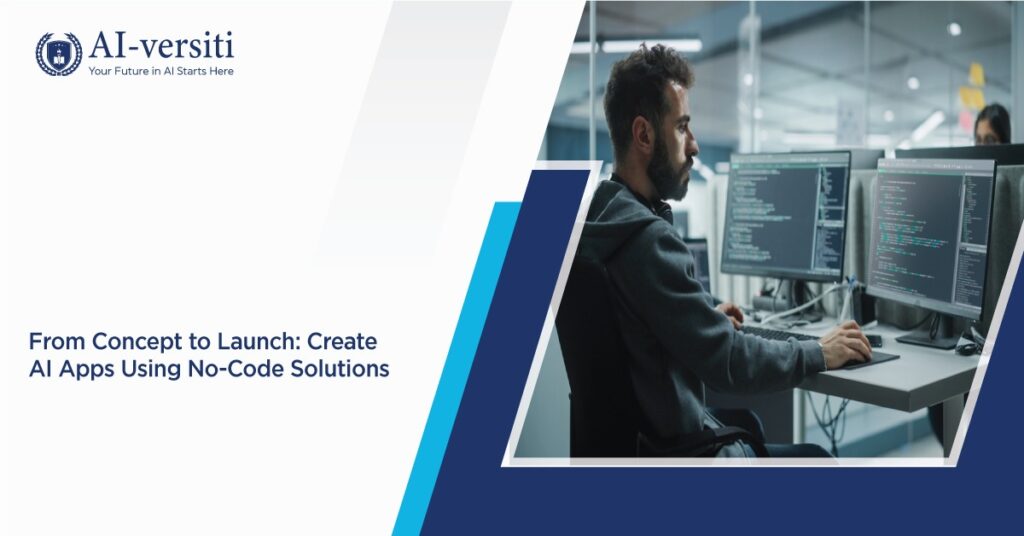The rise of no-code apps development has revolutionized how businesses create applications, especially AI-powered ones. Gone are the days when building an app required advanced programming skills. With drag-and-drop app builders and no-code tools, anyone, including citizen developers, can design functional apps tailored to their needs. This guide will walk you through the journey of using no-code solutions for creating AI apps, from conceptualization to launch.
Table of Contents
- Introduction to No-Code Development
- Why Choose No-Code for AI App Development?
- Key Features of No-Code Platforms
- Step-by-Step Guide to Building an AI App with No-Code Tools
- Benefits of Using No-Code for Business
- Popular No-Code Platforms for AI App Development
- How No-Code Enhances Workflow Automation
- Challenges and Limitations of No-Code Solutions
- Tips to Optimize Your No-Code App Development Process
- Future of No-Code in AI Development
- FAQs
Introduction to No-Code Development
No-code tools simplify app creation, allowing even non-technical users to build apps. They rely on visual programming interfaces, removing the need for coding. By leveraging cloud-based app builders, users can design apps for mobile and web platforms in record time. This paradigm shift has empowered businesses of all sizes to adopt code-free development solutions.
Why Choose No-Code for AI App Development?
Accessibility for All
Unlike traditional development, no-code platforms are designed for non-technical app creation. They enable DIY app development, breaking the barriers between ideas and implementation.
Speed and Efficiency
Using workflow automation tools and drag-and-drop app builders, businesses can achieve rapid app development, minimizing time-to-market.
Cost-Effective Solutions
Traditional app development often involves high costs. In contrast, low-code/no-code software offers budget-friendly alternatives.
Key Features of No-Code Platforms
1. Visual Programming Interfaces
A simple interface helps users visualize the structure and logic of their applications.
2. Integration with AI Tools
Many no-code platforms support custom app building by integrating AI functionalities like chatbots and automation.
3. Pre-Built Templates
Templates simplify app prototyping and accelerate development.
Step-by-Step Guide to Building an AI App with No-Code Tools
1. Define Your Goal
Start by outlining what your AI app should accomplish. For instance, is it a workflow automation tool, a chatbot, or an SaaS app?
2. Choose a No-Code Platform
Select a platform based on your app’s requirements. Examples include platforms specializing in mobile app development or web app creation.
3. Design the Interface
Using a drag-and-drop app builder, create a user-friendly design. Ensure your app is intuitive and visually appealing.
4. Integrate AI Functionalities
Most no-code tools offer plug-ins or integrations for AI. Connect your app with machine learning APIs for added intelligence.
5. Test and Iterate
Before launching, thoroughly test your app. Use app prototyping platforms to refine features.
6. Launch and Monitor
Deploy your app, gather feedback, and make improvements as necessary.
Benefits of Using No-Code for Business
- User-Friendly App Development: No prior coding knowledge required.
- Business Process Automation: Simplify repetitive tasks with ease.
- Scalability: Build apps that grow with your business.
- Enhanced Collaboration: Teams can easily work together using low-code platforms.
Popular No-Code Platforms for AI App Development
- Bubble: A versatile platform for web app creation.
- Zapier: Ideal for workflow automation tools.
- Adalo: Specializes in mobile app development.
- OutSystems: Combines low-code/no-code software with enterprise-grade solutions.
How No-Code Enhances Workflow Automation
No-code tools empower businesses to automate processes. From scheduling tasks to managing workflows, these platforms are pivotal for business process automation.
For example, a company can use cloud-based app builders to create apps that streamline communication between teams, saving time and resources.
Challenges and Limitations of No-Code Solutions
While no-code tools are transformative, they aren’t without challenges:
- Customization Limits: Advanced features may require traditional coding.
- Scalability Concerns: Some no-code platforms may not support large-scale projects.
- Integration Issues: Not all tools seamlessly integrate with existing systems.
Tips to Optimize Your No-Code App Development Process
- Choose the Right Platform: Match the platform’s strengths with your app’s goals.
- Start with Prototypes: Use app prototyping platforms to refine your ideas.
- Focus on User Experience: Keep interfaces clean and intuitive.
- Leverage Community Support: Engage with citizen developers for guidance.
Future of No-Code in AI Development
The future of no-code apps development is bright. As platforms evolve, we’ll see more capabilities for building sophisticated AI-powered apps. Companies like AIversiti are at the forefront, offering courses to equip users with skills for DIY app development.
FAQs
1. What are no-code tools?
No-code tools are platforms that allow users to create apps using visual programming, without the need for traditional coding skills.
2. Can no-code platforms support AI integration?
Yes, many no-code platforms support AI functionalities, such as machine learning APIs and chatbots.
3. Who can benefit from no-code development?
Anyone, from citizen developers to businesses, can benefit. It’s especially useful for those with no coding knowledge.
4. What are the best no-code platforms for beginners?
Platforms like Bubble, Adalo, and Zapier are great for beginners due to their user-friendly interfaces.
5. How secure are no-code apps?
Security depends on the platform. Opt for reputable cloud-based app builders with robust security measures.
Unlock your potential with no-code apps development today! For detailed guidance, check out AIversiti’s courses.

